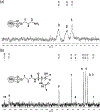Nitric Oxide Release and Antibacterial Efficacy Analyses of S-Nitroso- N-Acetyl-Penicillamine Conjugated to Titanium Dioxide Nanoparticles
- PMID: 35443135
- PMCID: PMC9721035
- DOI: 10.1021/acsabm.2c00131
Nitric Oxide Release and Antibacterial Efficacy Analyses of S-Nitroso- N-Acetyl-Penicillamine Conjugated to Titanium Dioxide Nanoparticles
Abstract
Therapeutic agents can be linked to nanoparticles to fortify their selectivity and targeted delivery while impeding systemic toxicity and efficacy loss. Titanium dioxide nanoparticles (TiNPs) owe their rise in biomedical sciences to their versatile applicability, although the lack of inherent antibacterial properties limits its application and necessitates the addition of bactericidal agents along with TiNPs. Structural modifications can improve TiNP's antibacterial impact. The antibacterial efficacy of nitric oxide (NO) against a broad spectrum of bacterial strains is well established. For the first time, S-nitroso-N-acetylpenicillamine (SNAP), an NO donor molecule, was covalently immobilized on TiNPs to form the NO-releasing TiNP-SNAP nanoparticles. The TiNPs were silanized with 3-aminopropyl triethoxysilane, and N-acetyl-d-penicillamine was grafted to them via an amide bond. The nitrosation was carried out by t-butyl nitrite to conjugate the NO-rich SNAP moiety to the surface. The total NO immobilization was measured to be 127.55 ± 4.68 nmol mg-1 using the gold standard chemiluminescence NO analyzer. The NO payload can be released from the TiNP-SNAP under physiological conditions for up to 20 h. The TiNP-SNAP exhibited a concentration-dependent antimicrobial efficiency. At 5 mg mL-1, more than 99.99 and 99.70% reduction in viable Gram-positive Staphylococcus aureus and Gram-negative Escherichia coli bacteria, respectively, were observed. No significant cytotoxicity was observed against 3T3 mouse fibroblast cells at all the test concentrations determined by the CCK-8 assay. TiNP-SNAP is a promising and versatile nanoparticle that can significantly impact the usage of TiNPs in a wide variety of applications, such as biomaterial coatings, tissue engineering scaffolds, or wound dressings.
Keywords: NO donor; antibacterial; biomedical application; nitric oxide; surface modification; titanium dioxide nanoparticles.
Conflict of interest statement
The authors declare no competing financial interest.
Figures







Similar articles
-
Long-Term Storage Stability and Nitric Oxide Release Behavior of (N-Acetyl-S-nitrosopenicillaminyl)-S-nitrosopenicillamine-Incorporated Silicone Rubber Coatings.ACS Appl Mater Interfaces. 2022 Jul 13;14(27):30595-30606. doi: 10.1021/acsami.2c06712. Epub 2022 Jun 27. ACS Appl Mater Interfaces. 2022. PMID: 35759508 Free PMC article.
-
A multi-defense strategy: Enhancing bactericidal activity of a medical grade polymer with a nitric oxide donor and surface-immobilized quaternary ammonium compound.Acta Biomater. 2017 Aug;58:421-431. doi: 10.1016/j.actbio.2017.05.061. Epub 2017 Jun 1. Acta Biomater. 2017. PMID: 28579540 Free PMC article.
-
A Synergistic New Approach Toward Enhanced Antibacterial Efficacy via Antimicrobial Peptide Immobilization on a Nitric Oxide-Releasing Surface.ACS Appl Mater Interfaces. 2021 Sep 22;13(37):43892-43903. doi: 10.1021/acsami.1c08921. Epub 2021 Sep 13. ACS Appl Mater Interfaces. 2021. PMID: 34516076
-
SNAP@CQD as a promising therapeutic vehicle against HCoVs: An overview.Drug Discov Today. 2023 Jul;28(7):103601. doi: 10.1016/j.drudis.2023.103601. Epub 2023 Apr 28. Drug Discov Today. 2023. PMID: 37119964 Free PMC article. Review.
-
Nitric Oxide (NO)-Releasing Macromolecules: Rational Design and Biomedical Applications.Front Chem. 2019 Jul 26;7:530. doi: 10.3389/fchem.2019.00530. eCollection 2019. Front Chem. 2019. PMID: 31403044 Free PMC article. Review.
Cited by
-
Engineering Nitric Oxide-Releasing Antimicrobial Dental Coating for Targeted Gingival Therapy.ACS Appl Bio Mater. 2024 May 20;7(5):2993-3004. doi: 10.1021/acsabm.4c00051. Epub 2024 Apr 9. ACS Appl Bio Mater. 2024. PMID: 38593411 Free PMC article.
-
Fe-containing metal-organic framework with D-penicillamine for cancer-specific hydrogen peroxide generation and enhanced chemodynamic therapy.Bioeng Transl Med. 2023 Feb 1;8(3):e10477. doi: 10.1002/btm2.10477. eCollection 2023 May. Bioeng Transl Med. 2023. PMID: 37206221 Free PMC article.
-
Cationic Liposomes with Different Lipid Ratios: Antibacterial Activity, Antibacterial Mechanism, and Cytotoxicity Evaluations.Pharmaceuticals (Basel). 2022 Dec 14;15(12):1556. doi: 10.3390/ph15121556. Pharmaceuticals (Basel). 2022. PMID: 36559007 Free PMC article.
-
Hydrogels for Gasotransmitter Delivery: Nitric Oxide, Carbon Monoxide, and Hydrogen Sulfide.Macromol Biosci. 2024 Jan;24(1):e2300138. doi: 10.1002/mabi.202300138. Epub 2023 Jul 12. Macromol Biosci. 2024. PMID: 37326828 Free PMC article. Review.
-
Recent Developments in Multifunctional Antimicrobial Surfaces and Applications toward Advanced Nitric Oxide-Based Biomaterials.ACS Mater Au. 2022 Sep 14;2(5):525-551. doi: 10.1021/acsmaterialsau.2c00040. Epub 2022 Aug 8. ACS Mater Au. 2022. PMID: 36124001 Free PMC article. Review.
References
-
- Furchgott RF; Zawadzki JV The Obligatory Role of Endothelial Cells in the Relaxation of Arterial Smooth Muscle by Acetylcholine. Nature 1980, 288, 373–376. - PubMed
-
- Moncada S; Higgs A; Furchgott R Xiv International Union of Pharmacology Nomenclature in Nitric Oxide Research. Pharmacol. Rev. 1997, 49, 137–42. - PubMed
-
- Nicholls M Nitric Oxide Discovery Nobel Prize Winners. Eur. Heart J. 2019, 40, 1747–1749. - PubMed
Publication types
MeSH terms
Substances
Grants and funding
LinkOut - more resources
Full Text Sources
Other Literature Sources
